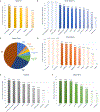An Open Resource for Non-human Primate Optogenetics
- PMID: 33080229
- PMCID: PMC7962465
- DOI: 10.1016/j.neuron.2020.09.027
An Open Resource for Non-human Primate Optogenetics
Abstract
Optogenetics has revolutionized neuroscience in small laboratory animals, but its effect on animal models more closely related to humans, such as non-human primates (NHPs), has been mixed. To make evidence-based decisions in primate optogenetics, the scientific community would benefit from a centralized database listing all attempts, successful and unsuccessful, of using optogenetics in the primate brain. We contacted members of the community to ask for their contributions to an open science initiative. As of this writing, 45 laboratories around the world contributed more than 1,000 injection experiments, including precise details regarding their methods and outcomes. Of those entries, more than half had not been published. The resource is free for everyone to consult and contribute to on the Open Science Framework website. Here we review some of the insights from this initial release of the database and discuss methodological considerations to improve the success of optogenetic experiments in NHPs.
Keywords: Gene therapy; Monkey; Monkeys; Non-human primates; Nonhuman primates; Open Science; Optical control; Optogenetic; Optogenetics; Viral vectors.
Copyright © 2020 Elsevier Inc. All rights reserved.
Conflict of interest statement
Declaration of Interests S. Palfi received consulting honorarium from OxfordBiomedica. K.V.S. is a consultant for Neuralink and is on the scientific advisory board for CTRL-Labs, MIND-X, Inscopix, and Heal. These entities did not support this work. P.N.S. has financial interests in Neuralink, a company developing clinical therapies using brain stimulation.
Figures







References
Publication types
MeSH terms
Grants and funding
- R01 NS078127/NS/NINDS NIH HHS/United States
- 095495/WT_/Wellcome Trust/United Kingdom
- R00 EY029374/EY/NEI NIH HHS/United States
- U01 NS099702/NS/NINDS NIH HHS/United States
- HHMI/Howard Hughes Medical Institute/United States
- U42 OD011123/OD/NIH HHS/United States
- R21 EY022853/EY/NEI NIH HHS/United States
- P50 MH094258/MH/NIMH NIH HHS/United States
- 204811/Z/16/Z/WT_/Wellcome Trust/United Kingdom
- R01 EY016454/EY/NEI NIH HHS/United States
- R01 MH110594/MH/NIMH NIH HHS/United States
- R01 EY026156/EY/NEI NIH HHS/United States
- R01 EY019743/EY/NEI NIH HHS/United States
- R01 MH116937/MH/NIMH NIH HHS/United States
- P51 OD011132/OD/NIH HHS/United States
- ZIA MH002958/ImNIH/Intramural NIH HHS/United States
- R01 EY031959/EY/NEI NIH HHS/United States
- R01 EY005911/EY/NEI NIH HHS/United States
- U01 MH109146/MH/NIMH NIH HHS/United States
- R01 EY011378/EY/NEI NIH HHS/United States
- U01 NS099720/NS/NINDS NIH HHS/United States
- R01 DE013962/DE/NIDCR NIH HHS/United States
- ZIA EY000415/ImNIH/Intramural NIH HHS/United States
- R01 EY029666/EY/NEI NIH HHS/United States
- R01 NS093998/NS/NINDS NIH HHS/United States
- MR/K013785/1/MRC_/Medical Research Council/United Kingdom
- R21 EY024516/EY/NEI NIH HHS/United States
- K99 EY029374/EY/NEI NIH HHS/United States
- R01 EY026812/EY/NEI NIH HHS/United States
- R21 EY026240/EY/NEI NIH HHS/United States
- P50 NS098685/NS/NINDS NIH HHS/United States
- R01 MH108627/MH/NIMH NIH HHS/United States
- P30 EY014800/EY/NEI NIH HHS/United States
- R01 EY014681/EY/NEI NIH HHS/United States
- DP1 HD075623/HD/NICHD NIH HHS/United States
- G0700976/MRC_/Medical Research Council/United Kingdom
- R01 EY013692/EY/NEI NIH HHS/United States
LinkOut - more resources
Full Text Sources
Other Literature Sources
Research Materials

